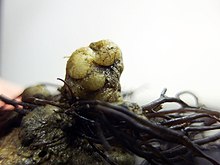| Styela plicata | |
|---|---|

| |
| Scientific classification | |
| Domain: | Eukaryota |
| Kingdom: | Animalia |
| Phylum: | Chordata |
| Subphylum: | Tunicata |
| Class: | Ascidiacea |
| Order: | Stolidobranchia |
| Family: | Styelidae |
| Genus: | Styela |
| Species: | S. plicata |
| Binomial name | |
| Styela plicata Lesuer, 1823 | |
Styela plicata, commonly known as pleated sea squirt, is a species of tunicate in the family Styelidae. This sessile filter feeder can expel water when threatened.
Description and life cycle
Styela plicata is a solitary tunicate. Tadpole larvae measure around 1.3 millimetres (0.051 in). Adults become sexually mature at around 40 millimetres (1.6 in), and were observed to reach this stage in laboratory after around 2 months in summer and 5 months in winter. Individuals live for 3 to 4 months after sexual maturity, independently of seasonal variations, and grow to a maximum size of 60 to 80 millimetres (2.4 to 3.1 in).
Distribution
In spite of Styela plicata's broad geographial distribution, its native range is still unclear. In 2021, an analysis of 368 individuals for the COI marker genes and 315 for the ANT marker gene from 17 worldwide locations revealed that S. plicata has been present in all studied oceans for a long time. Recurrent colonization events and occasional shuffling among populations have determined the actual genetic structure of this species.
Though the native range of S. plicata is unclear, the prevailing hypothesis is that they originated in the Northwest of the Pacific Ocean and then spread to other warm-water and tropical water bodies by ship fouling. As of 2021, genetic analyses remain inconclusive to either support or refute this hypothesis.
The range of Styela plicata has greatly expanded due to its ability to hitch a ride on ships' hulls. Long distance dispersal of S. plicata most likely takes place through international shipping, while short distance local dispersals take place through recreational boating and local traffic.
Preventative measures include anti-fouling paints, wood preservation, and slime control containing tributyltin.
Habitat
This species can live in a wide range of conditions, in waters from 10° to 30°C and salinities between 22%-34%. They also tolerate pollution and brackish water. The different life cycle stages of Styela plicata have different habitat requirements for survival. The larval and juvenile stages of Styela plicata live on marinas and docks, oyster reefs, rocks and coarse woody debris: adults prefer marinas, docks and hard rocky substrates. Styela plicata can also live in coral reef habitats, and is found from the low intertidal zone to depths of 30 metres.
References
- ^ Pineda, Mari Carmen; López-Legentil, Susanna; Turon, Xavier (2011-09-23). Kolokotronis, Sergios-Orestis (ed.). "The Whereabouts of an Ancient Wanderer: Global Phylogeography of the Solitary Ascidian Styela plicata". PLOS ONE. 6 (9): e25495. doi:10.1371/journal.pone.0025495. ISSN 1932-6203. PMC 3179514. PMID 21966535.
- Yamaguchi, M. (1975). "Growth and reproductive cycles of the marine fouling ascidians Ciona intestinalis, Styela plicata, Botrylloides violaceus, and Leptoclinum mitsukurii at Aburatsubo-Moroiso Inlet (central Japan)". Marine Biology. 29 (3): 253–259. doi:10.1007/BF00391851. ISSN 0025-3162.
- Carlton, James T. (2009), Rilov, Gil; Crooks, Jeffrey A. (eds.), "Deep Invasion Ecology and the Assembly of Communities in Historical Time", Biological Invasions in Marine Ecosystems, Ecological Studies, vol. 204, Berlin, Heidelberg: Springer Berlin Heidelberg, pp. 13–56, doi:10.1007/978-3-540-79236-9_2, ISBN 978-3-540-79235-2, retrieved 2024-10-03
- Barros, Rodolfo (2009). "Human-mediated global dispersion of Styela plicata (Tunicata, Ascidiacea)". Aquatic Invasions. 4 (1): 45–57. doi:10.3391/ai.2009.4.1.4.
- Goldstien, S. J.; Schiel, D. R.; Gemmell, N. J. (March 2010). "Regional connectivity and coastal expansion: differentiating pre-border and post-border vectors for the invasive tunicate Styela clava". Molecular Ecology. 19 (5): 874–885. doi:10.1111/j.1365-294X.2010.04527.x. ISSN 0962-1083. PMID 20149095.
- Thiyagarajan, Vengatesen; Harder, Tilmann; Qian, Pei-Yuan (March 2003). "Combined effects of temperature and salinity on larval development and attachment of the subtidal barnacle Balanus trigonus Darwin". Journal of Experimental Marine Biology and Ecology. 287 (2): 223–236. doi:10.1016/S0022-0981(02)00570-1.
- Pagad, Shyma. "Styela plicata (tunicate)". Global invasive species Database. Retrieved 2011-03-29.
| Taxon identifiers | |
|---|---|
| Styela plicata |
|